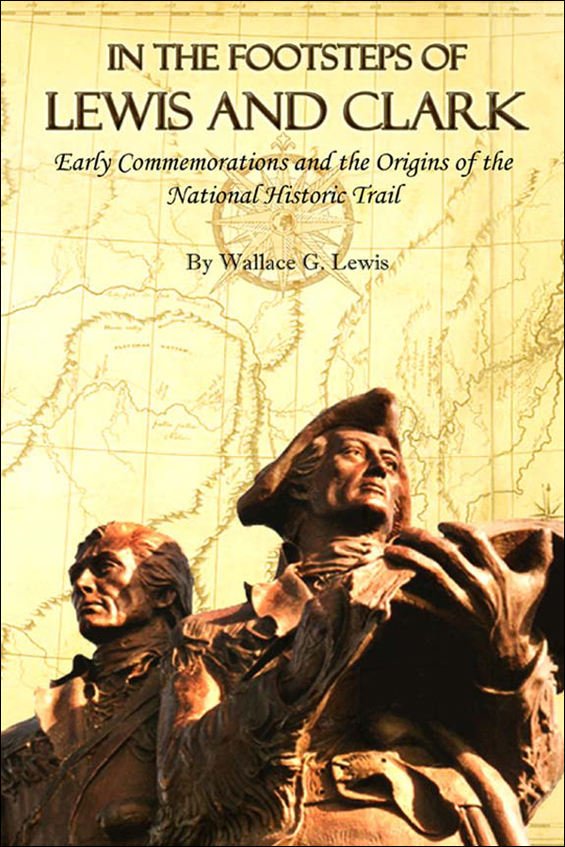In the Footsteps of Lewis and Clark
Read In the Footsteps of Lewis and Clark Online
Authors: Wallace G. Lewis


In the Footsteps of Lewis and Clark
LEWIS AND CLARK

Early Commemorations and the Origins of the National Historic Trail

Wallace G. Lewis
UNIVERSITY PRESS OF COLORADO
© 2010 by the University Press of Colorado
Published by the University Press of Colorado
5589 Arapahoe Avenue, Suite 206C
Boulder, Colorado 80303
All rights reserved
Printed in the United States of America
| The University Press of Colorado is a proud member of the Association of American University Presses. |
The University Press of Colorado is a cooperative publishing enterprise supported, in part, by Adams State College, Colorado State University, Fort Lewis College, Mesa State College, Metropolitan State College of Denver, University of Colorado, University of Northern Colorado, and Western State College of Colorado.
 The paper used in this publication meets the minimum requirements of the American National Standard for Information SciencesâPermanence of Paper for Printed Library Materials. ANSI Z39.48-1992
The paper used in this publication meets the minimum requirements of the American National Standard for Information SciencesâPermanence of Paper for Printed Library Materials. ANSI Z39.48-1992
Library of Congress Cataloging-in-Publication Data
Lewis, Wallace G., 1943â
  In the footsteps of Lewis and Clark : early commemorations and the origins of the
national historic trail / Wallace G. Lewis.
     p. cm.
  Includes bibliographical references and index.
  ISBN 978-1-60732-026-5 (hardcover : alk. paper) â ISBN 978-1-60732-027-2 (e-
book) 1. Lewis and Clark National Historic Trail. 2. Lewis and Clark Expedition
(1804â1806) I. Title.
  F592.7.L7157 2010
  917.804'2âdc22
                                                                                                          2010017171
Dust jacket design by Caroline Denney
Text design by Daniel Pratt
19Â Â 18Â Â 17Â Â 16Â Â 15Â Â 14Â Â 13Â Â 12Â Â 11Â Â 10Â Â Â Â Â Â Â Â Â 10Â Â 9Â Â 8Â Â 7Â Â 6Â Â 5Â Â 4Â Â 3Â Â 2Â Â 1
Portions of the introduction and
Chapters 1
and
4
originally appeared as “On the Trail: Commemorating the Lewis & Clark Expedition in the Twentieth Century,” in
Lewis & Clark: Legacies, Memories, and New Perspectives
, ed. Kris Fresonke and Mark Spence (Berkeley: University of California Press, 2004).
Portions of
Chapter 5
originally appeared as “Following in Their Footsteps: The Birth and Infancy of the Lewis and Clark National Historic Trail,” in
Columbia: The Magazine of Northwest History
16, no. 2 (Summer 2002): 37â42.
In memory of my father, Glenn C. Lewis 1920â2009

List of Illustrations and Maps
6.
Commemoration and Authenticity on the Trail

PHOTOGRAPHS
1.1.
Lewis and Clark Centennial parade, Helena, Montana
1.2.
Sacajawea
statue, Washington Park, Portland
1.3.
Close-up of
Sacajawea
statue
1.4.
Dedication of DAR plaque, Traveler's Rest, Montana, 1925
1.5.
Lewis and Clark column, Washington Park, Portland
1.6.
Astoria Column, Astoria, Oregon
1.7.
Close-up of Astoria Column
1.8.
Salt Cairn, Seaside, Oregon
1.9.
Lewis and Clark
End of the Trail
statue, Seaside, Oregon
1.10.
End of the Trail
plaque, Seaside, Oregon
1.11.
Scriver heroic-sized sculpture, Fort Benton, Montana
2.1.
Fort Mandan replica near Washburn, North Dakota
2.2.
White Cliffs of the Missouri River, Montana
2.3.
Big Falls of the Missouri River near Great Falls, Montana
2.4.
Gates of the Mountains, Missouri River
2.5.
The Three Forks of the Missouri River (headwaters)
2.6.
Gibbons Pass, Continental Divide
2.7.
Clearwater River near Orofino, Idaho
2.8.
Columbia River, east of the gorge
2.9.
Columbia River estuary near Astoria, Oregon
2.10.
Vicinity of Long Camp, Kamiah, Idaho
2.11.
Pompey's Pillar on the Yellowstone River, Montana
3.2.
Lochsa River and Lewis-Clark Highway, Idaho
4.1.
Fort Clatsop replica, doorway
4.2.
Sesquicentennial pageant (1955), Camp Fortunate site
4.3.
Men pulling boats up Beaverhead River in Dillon pageant, 1955
5.1.
Camp Fortunate monument, relocated when Clark Canyon Reservoir filled with water
5.2.
Beaverhead Rock and early automobile tourists
2.1.
The Lewis and Clark Expedition route, St. Louis to the Pacific Ocean and return

T
HIS BOOK GREW OUT OF MY FASCINATION
with both Lewis and Clark and the history of automobile tourism in the West. The now famous Lewis and Clark trail markers that began to appear along two-lane highways in the late 1960s seem to me emblematic of the way highway motoring and public historical awareness became intertwined in the twentieth century. The account that follows seeks primarily to explore and examine ways the Corps of Discovery was commemorated in the period between its centennial and the creation of the Lewis and Clark National Historic Trail by the U.S. Congress in 1978. As highway travel and tourism developed during that time, the public view of the expedition also shifted from a focus on the explorers and Sacagawea to an emphasis on the routes the Corps of Discovery took between 1803 and 1806. The climax of this narrative is not the Lewis and Clark Bicentennial in the twenty-first century
but rather the birth of the Lewis and Clark National Historic Trail in the twentieth century. In tracing various aspects of the process that led to that birth, I examined local newspaper stories that describe commemorative activities and express attitudes toward the history of the expedition. Many of them refer to locally installed monuments, markers, pageants, and similar commemorations, although I have not attempted to discuss or list all such instances.
